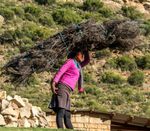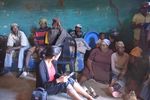SIPHÛTHÎ NARRATIVES: DOCUMENTING ORAL ACCOUNTS ON THE PAST AND PRESENT OF THE LANGUAGE AND ITS SPEAKERS
←
→
Page content transcription
If your browser does not render page correctly, please read the page content below
SiPhûthî
narratives:
Documenting
oral accounts on
the past and
present of the
language and its
speakers
Sheena Shah
Centre for African
Language Diversity,
University of Cape Town
SOAS University of
London
GBS final reportSiPhûthî and its speakers
SiPhûthî (S404, Maho 2009) is a severely endangered South-Eastern Bantu language. It is spoken by baPhûthî
communities who live scattered in rural parts of Lesotho and to a lesser extent in adjacent areas in South Africa. Most
baPhûthî live in two marginalised and poorly developed districts in south-western Lesotho, namely Quthing and
Qacha’s Nek. Access to electricity and running water, if available, is often limited; and infrastructure such as housing,
roads and schools in this part of Lesotho is very poor.
Bird’s eye view (left) and close-up view (right) of Ha Ramokakatlela, a predominantly siPhûthî-speaking village in the Qacha’s Nek
district.
It seems that there has been a drastic decline in the number of siPhûthî speakers in the last 60 years. The estimated
number of siPhûthî speakers in the late 1940s, according to Damane (1948:1), was 200,000. The most often quoted
current figure suggests 20,000 speakers, however, this is not based on any language census (cf. Donnelly 2007:7). My
own impressions based on visits to almost all siPhûthî-speaking villages in Lesotho in 2016 suggest that the actual
number of fluent siPhûthî speakers is much lower.
1Sesotho – also referred to as Sesotho sa Borwa or Southern Sotho, latter in contrast with Northern Sotho/Pedi – is
together with English the official language of Lesotho. SiPhûthî has no official status and does not receive any
governmental support.
The decline of siPhûthî and the lack of intergenerational language transmission among an increasing number of
households are in large part due to the dominance of Sesotho and intermarriage of baPhûthî with Sesotho speakers.
With the notable exception of the Daliwe River Valley, mixed marriages usually trigger a switch from siPhûthî to
Sesotho in the home domain. Another important factor that led to the decline of siPhûthî is the religious mission work
which started in the first half of the 18th century. BaPhûthî received the word of God through Sesotho and this
neglect of siPhûthî by the missionaries resulted in language shift to Sesotho among many baPhûthî communities.
With the exception of a few religious texts, no written materials exist in the language. SiPhûthî is not taught, not
even informally. Most teachers allocated to the siPhûthî-speaking areas neither speak nor understand siPhûthî. Today,
Sesotho and English are the media of instruction in Lesotho’s formal education system. All baPhûthî are fluent in
Sesotho, much less so in English. Sesotho is the mother tongue of most baPhûthî and also has a significant impact on
the siPhûthî spoken by the younger siPhûthî speakers in the Daliwe River Valley.
Students at the Daliwe Primary School, Quthing district. The ones standing identified themselves as baPhûthî (left).
School children from the Daliwe Primary School heading home (right).
2Map of the siPhûthî-speaking areas in Lesotho and South Africa (Donnelly 2007:2).
The Daliwe River Valley (marking of Mpapa on map) in the Quthing district is the core area of siPhûthî speakers
today. The baPhûthî communities in this valley seem to be the last speakers using siPhûthî on a daily basis. In most
3settlements in the valley, siPhûthî is still acquired by children and is often exclusively used in the homes. Other
siPhûthî-speaking settlements are dispersed in the Quthing district (predominantly in the Sinxôndô River Valley) and
in the Qacha’s Nek district. These communities live in language contact settings which are dominated by either
Sesotho or Thembu-isiXhosa. It seems that most children in these areas no longer speak siPhûthî but have shifted to
Sesotho.
While all baPhûthî have lost their ancestral traditions and culture by adopting Basotho culture, including male and
female initiation ceremonies, lifestyle, economy, art, etc., only some baPhûthî have retained the siPhûthî language.
The ancestral language siPhûthî is the core marker of baPhûthî identity only in the Daliwe River Valley. Elsewhere,
community members assume baPhûthî identity based on ethnic ancestry without reference to language competence
in siPhûthî.
SiPhûthî speakers in Ha Hlaela, Quthing district (left and centre), and in Mosenekeng, Qacha’s Nek district (right).
The GBS siPhûthî project
The baPhûthî communities in Lesotho asked for support in having their oral narratives and history documented.
This was the main objective of the GBS project. Oral narratives were recorded with half a dozen speakers of different
ages and gender from various villages in the Quthing and Qacha’s Nek districts using audio and video devices. The
recordings include diverse topics such as migration, language, culture, education, daily life, songs and prayers. Audio
and video files have been edited, transcribed, analysed, glossed and translated into Sesotho and English. They have
been archived at the Endangered Languages Archive / ELAR (https://elar.soas.ac.uk/Collection/MPI1102118). Some
4audio/video files are still being processed. The transcriptions, translations and annotations are expected to be
completed by the end of 2018. A printable version of the narratives including photos will be produced, and copies will
be printed and handed over to the baPhûthî communities in 2019.
Working with language consultants in Ha Hlaela, Quthing district (left), and Mosenekeng, Qacha’s Nek district (right).
The printable version of the narratives will support literacy in siPhûthî among the still predominantly non-literate
baPhûthî. At present, as far as I know, only two community members are writing in siPhûthî. The narratives will help
to strengthen ethnic and linguistic self-awareness, but most of all they will be a vital tool in the communities’
language maintenance efforts. The narratives will be distributed to schools, community centres, the baPhûthî society
(Ibadlha le baPhuthi), and all those who have personally contributed to the project and have shown interest. The
Morija Museum and Archives as well as the University of Lesotho in Roma will also receive copies.
Budget
The GBS budget of 1,497 Euros was spent as indicated in the proposal, approx. 1,000 Euros for travel, daily
subsistence and accommodation and approx. 500 Euros to compensate language consultants and interpreters.
5One of the main roads in the Qacha’s Nek district (left).
Horses are the most common means of transport in mountainous Lesotho (right).
Acknowledgements
I would like to express my sincere gratitude to the GBS for their kind and generous grant which supported the
development of materials for the highly endangered siPhûthî language. I would also like to thank the baPhûthî society
(Ibadlha le baPhuthi), and especially its President, Letzadzo Kometsi, and its Secretary, Lebuajoang Ramokhele, for
their significant contribution to this project. Thanks also to all the enthusiastic teachers and their students for sharing
their knowledge and experiences with me.
Many thanks to Maseeiso Nbueke for her assistance in interpreting in the Daliwe River Valley and to Naledi
Ramoabi (University of Cape Town) for her input in translating the recordings. I would especially like to express my
deepest gratitude to the baPhûthî communities in the Quthing and Qacha’s Nek districts for warmly welcoming me
into their lives and sharing their knowledge, stories and language with me.
Thanks also to Stephen Gill (Curator of Morija Museum and Archives, Lesotho), David Ambrose (retired from the
National University of Lesotho, Roma) and Fr. Simon Donnelly (Vatican, Italy) for sharing their knowledge. A special
6thanks to Matthias Brenzinger (Centre for African Language Diversity, University of Cape Town) who is part of this
project and who also took the photos used in the report.
References
Damane, M. 1948. Moorosi: Morena oa Baphuthi. Morija: Morija Sesuto Book Depot.
Donnelly, S. 2007. Aspects of Tone and Voice in Phuthi. Doctoral Dissertation, University of Illinois at Urbana-
Champaign.
Maho, J. F. 2009. NUGL Online: The Online Version of the New Updated Guthrie List, a Referential Classification of the
Bantu Languages. Version dated June 4th 2009. https://brill.com/fileasset/downloads_products/35125_Bantu-
New-updated-Guthrie-List.pdf
7You can also read



























































